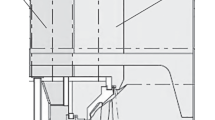The principles of a program for monitoring stresses in rotors and bodies of stop and control valves of nonreheat steam turbines of up to 180 MW capacity to control the startup processes are formulated. The program based on the experimental data obtained by the VTI and ORGRES and calculated results obtained with the finite-element method is intended for microcomputers with hardware integrated into the electronics of the control system or the automatic process control system. Using the data from the regular control and measuring instruments, the program estimates the stresses in the “critical” elements of the steam turbine, compares them with the level permissible for the material, depending on the operating temperatures, service life, design and other parameters, and generates signals to adjust the startup process. The equivalent operating hours can also be calculated to assess the quality of startups and shutdown processes, accumulated damage, and relative past life. These data can be taken into account when deciding on maintenance operations. The algorithm of the stress monitoring system is implemented in the program limiting the rate of spinup and power change from the thermal stress state of the rotors of the high- and intermediate-pressure cylinders of the T-185/210 – 16.0 turbine.
Similar content being viewed by others
References
L. Busse and J. Schmidt, “Application of life counters in steam turbines,” in: Proc. Int. Conf. on Evalutation of Remaining Life and Extension of Service Life of Power Units of Organic Fuel Fired TPPs. Vol. 2 [Russian translation], VTI, Moscow (1994), pp. 1 – 9.
D. Fichtner and K. Meer, “Stress monitor in steam turbines,” in: Proc. Int. Conf. on Evalutation of Remaining Life and Extension of Service Life of Power Units of Organic Fuel Fired TPPs [Russian translation], VTI, Moscow (1994).
E. R. Plotkin, A. Sh. Leizerovich, and Ya. D. Berkovich, “Information support of the operator during startup of 228 MW turbine,” Élektr. Stantsii, No. 10, 14 – 21 (2013).
Yu. A. Radin and T. S. Kontorovich, “Use of the principle of equivalent operating time in assessing the reliability of CCGT equipment,” Power Technol. Eng., 46(2), 129 – 131 (2012).
E. E. Goverdovskii, V. V. Kholshchev, Yu. I. Smirnov, E. R. Plotkin, Yu. A. Radin, D. E. Gubanov, and I. A. Oberderfer, “Startup modes of 110 MW cogeneration power unit,” Élektr. Stantsii, No. 3, 47 – 51 (1991).
Technical Guides RTM 108.021.103–85. Parts of Stationary Steam Turbines. Design for Low-Cycle Fatigue [in Russian], MÉM, Moscow (1985).
E. R. Plotkin and A. Sh. Leizerovich, Startup Modes of Steam Turbines of Power Units [in Russian], Énergiya, Moscow (1980).
S. P. Timoshenko, Theory of Elasticity, McGraw-Hill, New York (1934).
Author information
Authors and Affiliations
Corresponding author
Additional information
Translated from Élektricheskie Stantsii, No. 9, September 2019, pp. 8 – 13.
Rights and permissions
About this article
Cite this article
Radin, Y.A., Kontorovich, T.S. & Golov, P.V. Monitoring the Thermal Stress State in Steam Turbines. Power Technol Eng 53, 719–723 (2020). https://doi.org/10.1007/s10749-020-01146-6
Published:
Issue Date:
DOI: https://doi.org/10.1007/s10749-020-01146-6



